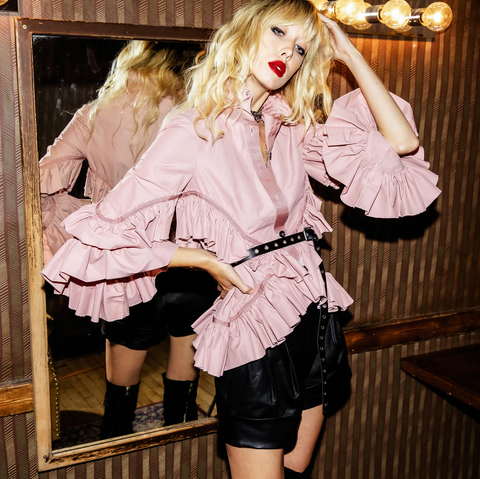
Fashion is not merely about clothing; it is a powerful vehicle that carries the essence of an era, reflecting the social, cultural, and political dynamics of its time. Throughout history, fashion has acted as a mirror, allowing us to delve into the past and understand the society that shaped it. In this blog post, we will embark on a journey through time, exploring how fashion evolved from the early 1800s to the present day, and how it intertwined with the tapestry of history.
The Early 1800s: Neoclassicism and Empire Style
In the early 19th century, Europe was undergoing a transformative period marked by political revolutions and the rise of Napoleon Bonaparte. Fashion of the time embraced the Neoclassical aesthetic, inspired by ancient Greece and Rome. Women's clothing featured high-waisted empire dresses, with loose and flowing silhouettes that symbolized a departure from the corseted styles of the previous century. This shift in fashion reflected a desire for freedom and equality, echoing the revolutionary ideals of the time.
Victorian Era: Restriction and Social Hierarchy
The Victorian era, spanning from the mid-19th to early 20th century, was a time of rapid industrialization and vast social changes. Fashion during this period was characterized by its adherence to strict social norms and divisions. The corseted hourglass figure became the ideal silhouette for women, representing societal expectations of beauty and femininity. Each layer of clothing symbolized class distinction, with elaborate gowns for the upper class and simpler garments for the working class. The fashion of the Victorian era encapsulated the rigid social hierarchy and the conservative values of the time.
The Roaring Twenties: Liberation and Jazz Age
The 1920s witnessed a significant shift in fashion, coinciding with the cultural transformation of the Jazz Age and women's suffrage movements. The "flapper" style emerged as a rebellion against the constraints of the past. Women embraced shorter hemlines, dropped waistlines, and loose, boyish silhouettes. The fashion of the Roaring Twenties symbolized the newfound liberation and independence of women, reflecting the changing social dynamics and a desire for freedom and self-expression.
Post-War Period: Dior's New Look and the Feminine Ideal
The aftermath of World War II brought forth a sense of optimism and a return to glamour. In 1947, Christian Dior's revolutionary "New Look" collection redefined women's fashion. The collection featured full skirts, nipped-in waists, and accentuated curves, emphasizing a return to traditional femininity. Dior's designs embodied the post-war desire for a renewed sense of elegance, offering an escape from the hardships of the past and reflecting the changing roles of women in society.
Contemporary Fashion: Individualism and Sustainability
The Early 1800s: Neoclassicism and Empire Style
In the early 19th century, Europe was undergoing a transformative period marked by political revolutions and the rise of Napoleon Bonaparte. Fashion of the time embraced the Neoclassical aesthetic, inspired by ancient Greece and Rome. Women's clothing featured high-waisted empire dresses, with loose and flowing silhouettes that symbolized a departure from the corseted styles of the previous century. This shift in fashion reflected a desire for freedom and equality, echoing the revolutionary ideals of the time.
Victorian Era: Restriction and Social Hierarchy
The Victorian era, spanning from the mid-19th to early 20th century, was a time of rapid industrialization and vast social changes. Fashion during this period was characterized by its adherence to strict social norms and divisions. The corseted hourglass figure became the ideal silhouette for women, representing societal expectations of beauty and femininity. Each layer of clothing symbolized class distinction, with elaborate gowns for the upper class and simpler garments for the working class. The fashion of the Victorian era encapsulated the rigid social hierarchy and the conservative values of the time.
The Roaring Twenties: Liberation and Jazz Age
The 1920s witnessed a significant shift in fashion, coinciding with the cultural transformation of the Jazz Age and women's suffrage movements. The "flapper" style emerged as a rebellion against the constraints of the past. Women embraced shorter hemlines, dropped waistlines, and loose, boyish silhouettes. The fashion of the Roaring Twenties symbolized the newfound liberation and independence of women, reflecting the changing social dynamics and a desire for freedom and self-expression.
Post-War Period: Dior's New Look and the Feminine Ideal
The aftermath of World War II brought forth a sense of optimism and a return to glamour. In 1947, Christian Dior's revolutionary "New Look" collection redefined women's fashion. The collection featured full skirts, nipped-in waists, and accentuated curves, emphasizing a return to traditional femininity. Dior's designs embodied the post-war desire for a renewed sense of elegance, offering an escape from the hardships of the past and reflecting the changing roles of women in society.
Contemporary Fashion: Individualism and Sustainability
In recent times, fashion has become a platform for individual expression, cultural exploration, and activism. The rise of fast fashion has brought accessibility but also raised concerns about environmental sustainability and ethical practices. As a response, we have witnessed the emergence of conscious fashion movements, promoting eco-friendly materials, ethical production, and diverse representation. Fashion today reflects a desire for inclusivity, body positivity, and a growing awareness of the impact our choices have on the world.
Fashion has always been deeply intertwined with the fabric of history. From the early 1800s to the present day, clothing styles have evolved, responding to social, political, and cultural changes. Whether it was the revolutionary spirit of the early 19th century, the social stratification of the Victorian era, the liberation of the 1920s, or the post-war quest for glamour, fashion has been an ever-evolving reflection of society. As we navigate the complexities of the present, fashion continues to serve as a canvas for self-expression, a catalyst for change, and a vivid testament to the times we live in.
Fashion has always been deeply intertwined with the fabric of history. From the early 1800s to the present day, clothing styles have evolved, responding to social, political, and cultural changes. Whether it was the revolutionary spirit of the early 19th century, the social stratification of the Victorian era, the liberation of the 1920s, or the post-war quest for glamour, fashion has been an ever-evolving reflection of society. As we navigate the complexities of the present, fashion continues to serve as a canvas for self-expression, a catalyst for change, and a vivid testament to the times we live in.
